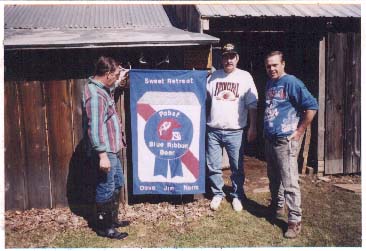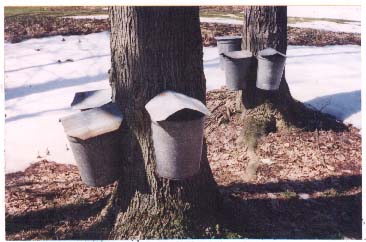It's maple syrup time. For over
a thousand years, the people who lived in this area have
boiled down sap in early spring to make maple syrup. In
Europe, maple syrup was unknown. It is truly an Native
American invention. The local Indians taught the early
settlers how to tap trees and make syrup. There are still
a few local folks here in Western New York who carry on
this time honored tradition in small backyard operations.
Norm Button is one of them.
Norm and his partners, Jim Roraback
and Dave Barr (see illustration) have a sugar shack in
Norm's back yard, right on Wesleyan Street in the village
of Panama. We visited them on a Sunday morning in
mid-March when they were fired up and boiling sap. Norm's
son Todd was there, along with a steady stream of
neighbors and friends naturally drawn by the spring
weather, the activity, the steam rising from the chimney
and the smell of syrup boiling. We certainly found it a
warm, pleasant, and interesting way to spend an early
spring day. The shack is named "Sweet Retreat". The
partner's wives gave them a flag to fly in front (see
illustration). The guys said that making maple syrup is
something to keep them busy between Superbowl Sunday and
March Madness (college basketball playoffs).
Norm, Jim and Dave have 250 buckets
collecting sap. About 200 are in the neighborhood. You'll
see them along Wesleyan Street, in the creek bed, and as
far as Hugh Wood's big maples next to the school. They
have 50 more at Ted Card's, near Bear Lake. The sap is
collected from the buckets on the trees. Then it is
strained into a big barrel on the back of a truck. The
next stop is Norm's garage, where the sap is transported
by sump pump through a garden hose back to the sugar
shack.
In the sugar shack the sap is filtered
into a large plastic drum. As they need it, they pump it
up into a a high stainless steel pan in the shack. The
sap is gravity fed from the pan into a evaporating unit.
The heat for evaporation is supplied by a wood stove
charged with an electric blower. First the sap goes
through a 30 foot copper coil under a hood over the
stove. This quickly preheats the sap to a high
temperature in a short time. Hot water condensation under
the hood is captured and drawn off for cleaning filters
and equipment. The copper coil empties into another pan
which has a float controlling the flow of sap from the
pan above. It is further heated here and then flows into
a series of four evaporative troughs. You can see the
gradation of syrup getting darker and thicker in each
successive trough. The last trough has a manually
operated gate which isolates the last batch until it
boils down to syrup.
They determine whether the sap is
ready by first visually inspecting the color and the size
of the bubbles in the boiling sap. Then viscosity is
checked using a straight edged sampler to see how it
drips. The crucial test is the hydrometer, which is a
calibrated float marked with the minimum density for
syrup. The grades of syrup are determined by a color
test. The final step is filtering twice more through felt
bags and into the jugs.
The whole process takes about a half
hour for one gallon of syrup. It takes 40-60 gallons of
raw sap to make 1 gallon of maple syrup. We were
surprised to find that the raw sap is very clear and thin
and looks just like water, although it does have a
slightly sweet taste. Norm, Jim and Dave are hoping to
make about 200 gallons this year, which we're sure will
delight their families and friends. We did get a taste of
the finished product, warm off the evaporator. Even
though we've used pure local maple syrup exclusively for
years, Sweet Retreat was the best syrup we've ever
tasted!

Dave Barr, Jim Roraback & Norm Button at Sweet
Retreat
Norm Button hasn't always used such
high-tech equipment to make syrup. He began making syrup
as a boy. Around 1950, he and a group of friends built a
sugar shack on Lee Wilson's land in Panama. Norm started
his first sugar shack there with Bill Sard, Charlie and
Nancy Pegan. See the photo, and if you can identify the
fourth boy in the picture, please let us know. It was in
'50 or '51, and Norm can't remember who the other boy
was. These kids begged, borrowed or stole twenty old
buckets. They built a stone and brick fireplace, a shack
from scraps, and found an old pan to boil down the sap.
The resulting syrup was probably not the best quality,
but their families certainly appreciated it. When the
kids got hungry, they would take some eggs from Lee
Wilson's chickens and boil them up in the cooking syrup.
In fact, Norm and his partners still boil eggs in their
evaporator.
It seems Norm has always had maple
syrup running through his veins. He's made at least 15
makeshift evaporators over the years. He told us a story
of the days before he had good equipment, when he had to
finish off the boiling process in his kitchen. Besides
being a sticky mess, he once steamed the wallpaper right
off his kitchen wall while making syrup at his home in
Ashville. He said his wife Cheryl appreciates the new
equipment that allows the whole process to be completed
out in the sugar shack. The Sweet Retreat partnership
started about five years ago with a cut-up 55 gallon
drum. They recently acquired the new evaporator.
Things have changed over the years.
Small family backyard operations once flourished, but
most have died off, leaving only big time operations.
Many of these use a plastic line system to collect syrup,
rather than the old metal buckets hanging on the trees.
Consumers pouring 100% Vermont Maple Syrup on their
pancakes don't realize that a large share of the sap
actually comes from commercial operations here in Western
New York.
Many maple trees along the roadside
have been lost to road salt damage and cut down to widen
roads. People aren't planting maple trees like they used
to, either. It would be a shame to have a local,
indigenous industry die off from lack of maple trees in
the next generation. Hard maples, or sugar maples, are
the ones that are used for syrup. They have tighter bark,
and produce much more sap than soft maples or other tree
species. If you have sugar maples on your property, talk
to a local syrup producer and see if they will tap your
trees. If you don't have trees, and you want to leave
your children or grandchildren an invaluable legacy in
about forty years, then plant some sugar maples now!
Home

